Types of manorial record
Manorial records are found in a number of different forms. The main record types are as follows:
There were two kinds of manorial court:
- court baron
- court leet with view of frankpledge
The court baron was the principal type of manorial court . It administered the customs of the manor and dealt with any offences against it. It also recorded the surrender and admission to copyhold land, held of the manor. It dealt with various matters affecting the local community, such as the regulation of agricultural affairs, the enforcement of labour services, the administration of justice for minor crimes, and the election of local officials.
A court baron would typically have been held every three or four weeks, although for some manors the gap between courts could have been much larger.
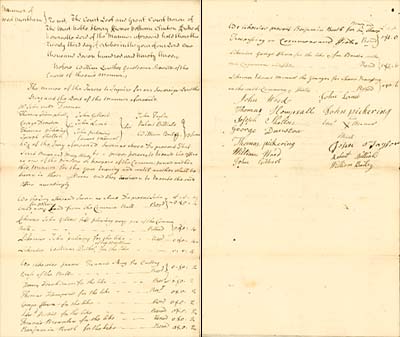
Court roll of the manor of West Markham (Ne M 210), with detail below

The court leet was more concerned with the enforcement of law and order and represented the transfer of jurisdiction normally exercised in the royal courts to the local, manorial lord or lady. It inspected the working of the frankpledge - a system of mutual responsibility for the maintenance of law and order. This is often referred to as the 'view of frankpledge'. It would also try offences such as assaults, obstruction of highways, or the breaking of the assize of bread and ale. It might also deal with the election of local officials such as constables. The court leet was normally held every six months.
As the name implies, early manorial court rolls were normally written on pieces of parchment (and later paper) which were stitched together and made into rolls. From the sixteenth century onwards it was not uncommon for the rolls to be entered in a volume. Each 'roll' usually began with a heading which stated the name of the manor in question on the left, and would then record the type of court, the name of the lord or lady of the manor, where the court was held and when, and the name of the presiding official.
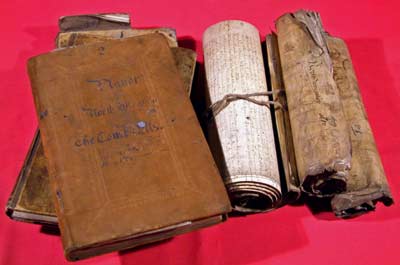
Photograph of court rolls from the manor of North Wheatley (NWM 1/1-8)
After the heading, the business of the court was normally divided into distinct sections. There may well be a list of the names of tenants who failed to attend the court; a record of changes in tenancy such as surrenders and admissions; a list of names of manorial jurors; a list of 'presentments', or offences to be considered by the jury; details of amercements, or fines, issued by the jury for offences; a list of 'pains', or regulations of the manor; and a record of the election of officials.
Accounts
Accounts of the manorial income and expenditure would have been kept by the manor's steward or bailiff. Each account would nearly always cover a single year, running from Michaelmas (29 September) to Michaelmas and would take the form of a 'charge and discharge'. The 'charge' was effectively the income, or monies received by the steward. These might be from rents, the sale of produce or from fines issued in the manorial court. The 'discharge' was a record of expenditure, or monies paid out by the steward - perhaps for purchasing corn or livestock, repairing buildings or paying for labour.
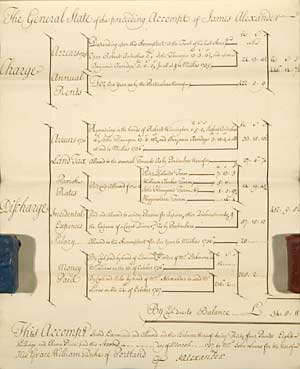
Summary of account from the manor of Dracklow and Rudheath (Pl E4/1/20/1)
Manorial accounts were often also preserved as a 'roll' and sometimes there might be both a draft and final version of the account included. The figures were usually set out according to a fairly standard format: they would begin with a record of the cash account, with details of the charge and discharge; next they might have a record of the corn account (a record of corn harvested or sown, for example), again with the charge and discharge; then they might have a record of the livestock account (for examples calves born on the manor or pigs dying), also with a charge and discharge; finally, there might be sections recording labour services due and performed, land available and how it was used, or implements which were remaining at the end of each year. At the end of every section there would be a balance, with a final balance at the end of the whole account.
Rentals
A rental was a list of the names of all tenants who held land in the manor, together with a description of the land they held and a record of the rent they paid. The rent might be in cash or in produce. Sometimes rentals might also include details of the services due from each tenant. Rentals were not made as frequently as court rolls or accounts - for example a rental may only have been made when a new lord or lady of the manor was taking over - and as a result, they do not survive in as large numbers.
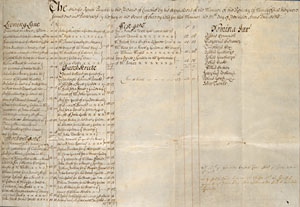
Rental of the manor of Mansfield (Pl E12/6/19/192/10), with detail below
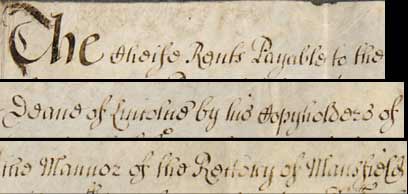
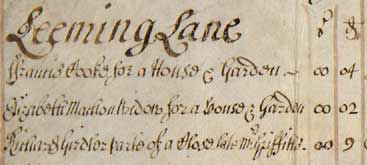
It was common that rentals would also take the form of a roll, written on either parchment or paper. Again, they would be organised in a fairly standardised way, possibly with the tenants dealt with by type of tenure, and then possibly on a place-by-place or parish-by-parish basis.
Custumals
Custumals were a survey of rents, services and other obligations owed by tenants to the lord or lady of the manor, and also of the rights and obligations of the lord or lady. They might sometimes begin with a recital of the 'customs' of the manor. They formed a legal and theoretical record of rights and obligations and as time went on, the services and produce listed in them might be commuted to monetary payments. The 'customs' would vary significantly from manor to manor.
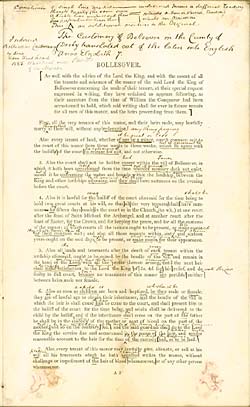
Custumal of the manor of Bolsover (Pl E12/10/1/7/5) with detail below
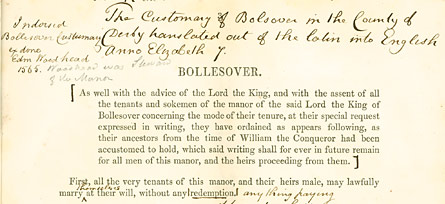
Extents
An extent was a description and valuation of all the items on the manor. The valuation was essentially the amount which could be got for the item if it were leased out. It was usually written in a set order, beginning with the manor house and its gardens and grounds, then moving on to mills, then to the demesne land (divided into sections for arable, meadow, pasture and woods) then setting out details of tenants' rents and services, and concluding with the total value of the manor. Extents were normally earlier in date than rentals, reflecting the movement away from demesne lands being worked by the lords or ladies of the manor themselves, to being leased out for rents.
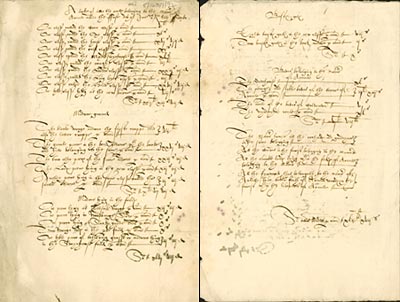
Extent of the manor of Arnold (Mi 5/169/1/92) with detail below

Maps
From the sixteenth century onwards, some manorial lords and ladies began to employ surveyors and cartographers to make maps of their lands. Such maps would provide details of the boundaries of the manor and might include information on adjoining manors and parishes. Of course, topographical features would also be marked on the maps and different types of land could well be identified. As time went on, maps were much more likely to have been properly measured and drawn to scale.
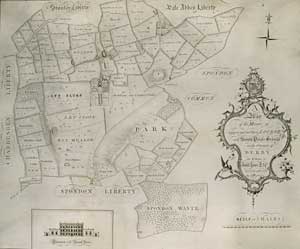
Map of the manor of Upper and Nether Locko (Dr 4 P2) with detail below
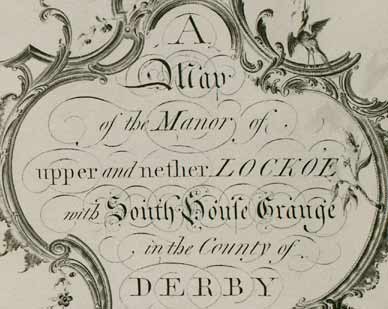
Next page: Skills required to interpret manorial records